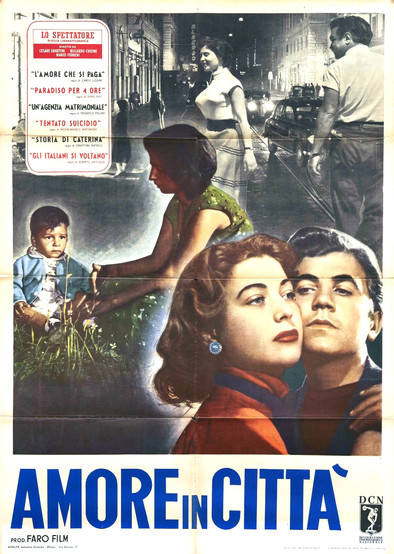Having discovered a rich vein in Italian social realist cinema of the immediate post-war period over lockdown that produced directors of the calibre of Fellini and Antonioni, I'm always on the lookout for films I haven't seen, especially of the "Commedia All Italiana" variety that combined social commentary with wry comedy and where the focus was very often on the female characters.
On that last point, there was clearly a marketing dimension for the decision to place women center stage though it becomes clear that more often than not, the plight of women was very much a concern for the writers and directors involved, though as I've mentioned before, for the most part, production teams were very male-oriented.
I picked "Love In The City" at random from the list of films available on Amazon Prime after initially doing a search for "Il Disco Volante", an Alberto Sordi / Monica Vitti starrer that uses a faux-documentary / comedy style to investigate the mystery surrounding flying saucers that seemed to preoccupy newspapers and media in the post-war years - unfortunately it's not available anywhere.
"Love In The City" (Italian: "Amore in Citta") uses a similar faux-documentary style broken down into chapters, with each segment helmed by a different director, most notably in this case featuring segments directed by Federico Fellini and Michelangelo Antonioni. As usual, the marketing strategies used by distributors to attract audiences is reflected in the posters above, ranging from mildly titillating to tabloid shock horror and the film references this tabloid approach by using the framing device of newspaper reports to preface each section.
The film is a collection of anecdotal stories based on real events and people but using a combination of actual interviews and pieces performed by actors. The opening segment, entitled "Paid Love", focusses on the prostitutes on Rome and there's a curious sense of voyeurism that pervades the segment while at the same time aiming to highlight the wretched prospects for women who are often abandoned by their partners, often as single parents, for a life on the streets and includes interviews with actual prostitutes combined with re-enacted sequences by actors.
The men who feature are for the most part anonymous and uncaring and out of the six films perhaps Antonioni's segment, "Attempted Suicide", is the most affecting as it gathers together various citizens of either gender who have attempted suicide for various reasons, in particular, two young women who have been seduced and then abandoned, often with a child by their feckless lovers who refuse to accept responsibility.
"Paradise for Three Hours" (Dir: Dino Risi) centers on dance hall life which in common with many Western countries performed the function of being a socially acceptable meeting place for the sexes. Here we see the gigolos and lovers crowded together in sweaty proximity to each other before the night passes and they go their separate ways after the inevitable brawl that breaks out when a much older man brings along his younger partner who becomes the focus of attention for all the young men.
"Marriage Agency" (Dir: Federico Fellini) concerns the brother of a young woman from the provinces who has signed up with a city marriage agency and has found a wealthy potential suitor and how he gradually persuades her to not to follow the money because it can only lead to disappointment and possible exploitation, to which she reluctantly agrees.
"The Story of Caterina" possibly matches the impact of "Attempted Suicide" in its investigation of the attempted abandonment of a toddler by his single parent mother, a maid, who is driven to this desperate act following a previous criminal charge for abandonment and from being sent from pillar to post in her attempts to find a secure home for the child that she can no longer look after.
The scene where she leaves the child in a park and walks away has considerable power and is an unflinching look at something that would have normally been experienced as just another column in the daily newspapers, and in fact this is highlighted in a scene where Caterina asks a news-vendor for a paper where she reads that an abandoned child has been found and that the mother is being sought, which leads to her relenting and being reunited with her son.
The oddest segment, "Italians Stare" (Dir: Alberto Lattuada) manages to subvert the serious tone of the preceding segments with a light-hearted but slightly uncomfortable expose of male attitudes to women as the camera follows a selection of young Roman women through the streets as various men ogle them, follow them down the street or curb-crawl, making use of comedy to highlight the absurdity of the male gaze.
Pointed breasts, voluptuous wasp-waisted figures and calves on stockinged high-heeled legs feature heavily in an attempt to lighten the tone of the previous segments but succeeds only in being voyeuristic without being overly judgmental since the balance of power is clearly weighted toward the women featured and once again I did wonder if this segment was tacked on with a view to the marketing of the film, cleverly placing it at the very end of the series of short films covering serious topics.
The film fits into a genre of drama-documentary that characterized a strand of Italian cinema in the 1950's and 60's that reached a conclusion with the "Mondo Cane" series of films that tested the limits of what would be acceptable and were devoid of the social political or critical commentary of an earlier generation of filmmakers and that typified the works of directors like Fellini and Antonioni, instead aiming for shock value.
"Love In The City" is interesting as a social document that also highlights the preoccupations of a certain generation of Italian neorealist film-makers in as much as it centers on the plight of women in society with a sympathetic eye, even if it is very often from a wholly male perspective.
"Love In The City", Dir's: Various, 1953
Amazon Prime






Comments